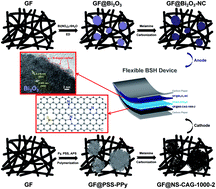High-performance Bi2O3-NC anodes through constructing carbon shells and oxygen vacancies for flexible battery-supercapacitor hybrid devices†
Abstract
Battery-supercapacitor hybrid (BSH) devices generally provide both high energy density and power density, but usually suffer from the serious electrochemical kinetics mismatch of cathodes and anodes mainly due to complex faradaic reactions of the unmatched battery-type electrodes used for charge storage, which inevitably degrade the rate capability and power density. To solve this, we propose a facile and efficient strategy of constructing carbon shells and oxygen vacancies. Oxygen-deficient Bi2O3 nanoflakes stabilized by N-doped carbon and supported on graphite fibers (GF@Bi2O3–NCs) were prepared to improve specific capacity, rate capability and cycling stability. The N/S-codoped carbon aerogels supported on graphite fibers (GF@NS-CAGs) provided a high capacitance of 312 F g−1 at 1 A g−1, which was mainly attributed to the microporous structure and high active N content. The flexible quasi-solid-state BSH device based on the GF@Bi2O3-NC anode and the GF@NS-CAG cathode with a stable voltage window of 2.3 V could deliver a remarkable capacity of 103 mA h g−1, an energy density of 118 W h kg−1 and capacity retention of 95.7% after 10 000 cycles, reflecting that this was a highly-efficient approach to develop high-performance flexible energy storage devices.



 Please wait while we load your content...
Please wait while we load your content...